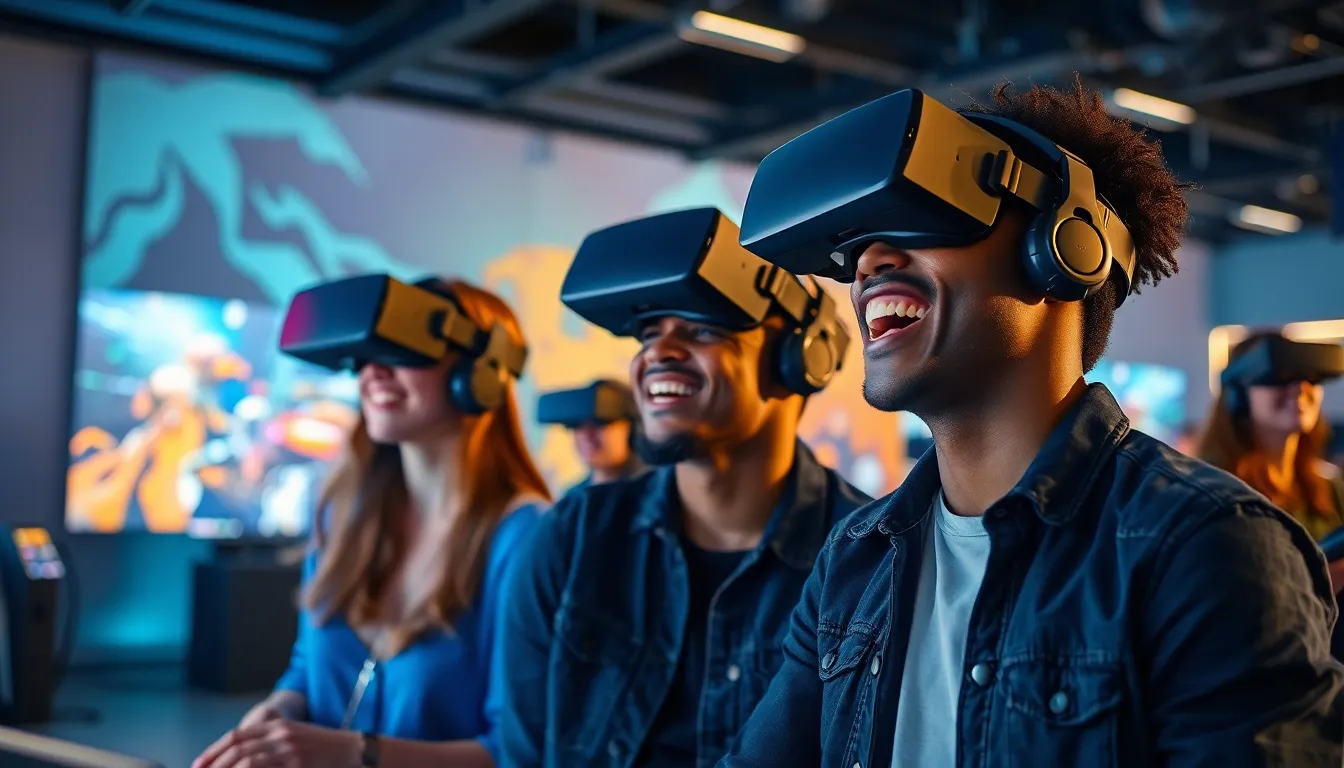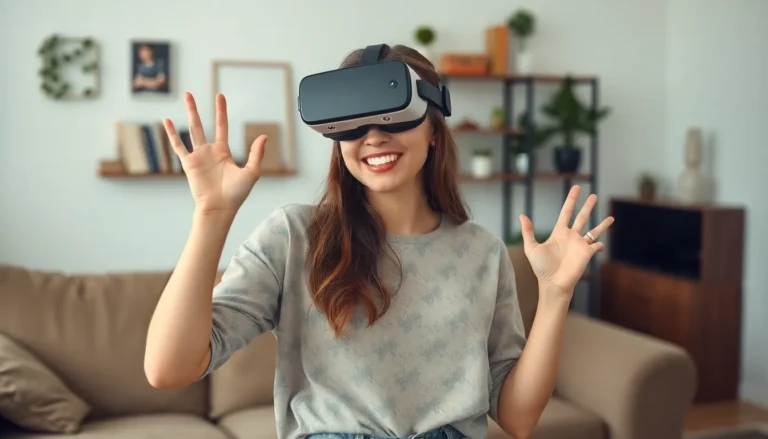Virtual reality technology isn’t just for gamers anymore; it’s infiltrating every corner of life, from education to therapy. Imagine slipping on a headset and suddenly finding yourself in a medieval castle or floating through outer space—all without leaving your living room. It’s like a ticket to a world where the only limit is your imagination, and who wouldn’t want that?
Table of Contents
ToggleOverview of VR Technology
VR technology creates immersive environments, allowing users to engage with digital worlds. Applications extend into numerous fields, enhancing user experience and learning.
In education, VR serves as a powerful tool for interactive teaching. Students explore complex concepts through simulations, increasing retention and understanding. For instance, medical students practice surgeries in controlled, virtual settings, gaining hands-on experience without real-world risks.
Therapeutic uses highlight VR’s effectiveness in mental health treatments. Exposure therapy, using virtual scenarios, helps individuals confront their fears in a safe space. Research shows that patients with PTSD benefit from immersive experiences, leading to significant reductions in anxiety.
Business sectors utilize VR for training and collaboration. Companies conduct virtual meetings, reducing travel time and costs while promoting remote teamwork. This approach fosters productivity and employee engagement across diverse locations.
Entertainment continues to thrive alongside these applications. The gaming industry leads in VR innovation, creating highly engaging experiences. Gamers immerse themselves in rich narratives, blurring the line between reality and fiction.
Market growth of VR technology supports diverse innovations. The global VR market was valued at approximately $15 billion in 2020, projected to reach $57 billion by 2027. This surge underscores the increasing integration of VR across industries.
Current VR systems encompass various hardware components. Headsets, motion controllers, and sensory gloves enhance user interaction and immersion. Enhanced graphics and sounds create compelling environments that captivate users.
The future of VR technology promises exciting developments. As advancements continue, expectations grow for VR to revolutionize everyday activities beyond gaming. Users can anticipate expanded horizons in interaction, learning, and entertainment.
Applications of VR Technology

VR technology finds extensive applications across several domains, enhancing user experiences and offering innovative solutions.
Gaming Industry
The gaming industry significantly benefits from VR technology, providing players with immersive environments. Players explore richly developed worlds, experiencing narratives that engage their senses. VR headsets place users directly into the action, increasing engagement and excitement. By enabling social interaction, VR gaming fosters collaborations among players, even when they’re miles apart. According to recent statistics, the VR gaming market was valued at approximately $1.4 billion in 2020. Projections suggest it could surpass $12 billion by 2024, highlighting its rapid growth.
Education and Training
In education and training, VR technology transforms traditional teaching methods into interactive experiences. Students visualize complex concepts through 3D simulations, making learning more effective. Medical students, for instance, gain hands-on experience by practicing surgeries in a virtual environment. This method not only enhances skill acquisition but also reduces the pressure of real-life consequences. Reports indicate that educational VR market revenues could reach $13 billion by 2026, showcasing a shift towards innovative teaching strategies.
Healthcare
Healthcare applications of VR technology are expanding, particularly in mental health and rehabilitation. Exposure therapy utilizes VR to help individuals confront phobias in a controlled setting. Patients with PTSD experience significant benefits when engaging with virtual scenarios tailored to their fears. Physiotherapy also incorporates VR, aiding patients in their recovery through engaging exercises. Research demonstrates that VR can decrease recovery time and improve outcomes. As the healthcare sector increasingly adopts this technology, the potential for enhanced patient care continues to grow.
Benefits of VR Technology
VR technology offers numerous advantages across various fields, significantly transforming how users interact with content and environments.
Immersive Experience
Users gain a truly immersive experience with VR, which allows them to engage with digitally created environments in a highly realistic manner. Virtual reality creates scenarios that feel authentic, from exploring historical landmarks to conducting virtual surgeries. These immersive experiences foster emotional connections and enhance memory retention. Studies indicate that such interactive settings make learning and training more effective. With the ability to evoke a strong sense of presence, VR empowers individuals to navigate complex tasks more confidently, often simulating challenging real-world situations.
Enhanced Learning
Education sees significant improvement through the integration of VR, as it enables learners to visualize and grasp intricate concepts more effectively. Medical students practicing in lifelike 3D simulations gain practical skills without real-world consequences. Science classes immerse students in environments that illustrate complex phenomena, such as cellular structures or astronomical events, which helps solidify understanding. Research highlights that experiential learning through VR increases student engagement, retention, and overall performance. Collaborative learning environments become more dynamic, enriching peer interactions and promoting teamwork among students.
Challenges and Limitations
VR technology faces several challenges that hinder its widespread adoption. Technical issues and user acceptance are two major obstacles impacting growth across industries.
Technical Barriers
VR systems rely heavily on advanced hardware and software, which can be costly to develop and maintain. High-resolution headsets and precise motion tracking equipment pose significant financial challenges for both consumers and developers. Additionally, compatibility issues between different VR platforms create fragmentation in the market. This inconsistency hampers developers’ ability to reach a broader audience. Furthermore, developers must navigate complex development environments, leading to longer production times and additional expenses. These technical limitations result in a slower rollout of VR applications across sectors.
User Adoption
User adoption remains a significant hurdle for VR technology, despite its potential benefits. Many users express concerns about motion sickness and discomfort during prolonged use. Studies show that nearly 40% of users experience symptoms, deterring potential customers. Moreover, a lack of familiarity with VR systems fosters hesitation among non-technical users. Many individuals find navigating the technology daunting, which slows adoption rates. Accessibility issues, particularly for individuals with disabilities, also limit the technology’s reach. As a result, there’s an urgent need to address these concerns to enhance user experience and increase acceptance.
Future Trends in VR Technology
Innovations in VR technology are set to reshape various sectors. The incorporation of artificial intelligence enhances user interactions in virtual environments. Companies are using data analytics to customize experiences based on user preferences. Enhanced graphics and resolutions will improve realism, making interactions more immersive.
Advancements in hardware are also imminent. Lower costs for high-quality VR headsets will increase accessibility. Wireless technology promises freedom from tangled cords, allowing users to move naturally. Additionally, lighter and more ergonomic designs will enhance comfort during extended use.
Industries beyond gaming are embracing VR solutions. The healthcare sector continues to explore VR for surgical training and patient treatment. Education will expand its curriculum to include virtual field trips and simulations, enriching students’ learning experiences. Corporate environments benefit from VR through virtual offices and collaborative tools that foster teamwork.
Integration of social VR platforms is gaining traction. Users can connect in shared virtual spaces, enabling social interactions that mimic real-life experiences. As multiplayer capabilities improve, people will partake in collaborative projects or simply socialize.
The emergence of mixed reality combines VR and augmented reality, allowing blended experiences. Users can interact with both digital and physical objects seamlessly. This technology will see applications in retail, where virtual try-ons enhance customer engagement.
As sustainability becomes a focal point, VR is expected to aid in reducing carbon footprints. Virtual meetings eliminate travel needs, thus decreasing emissions related to commuting. Furthermore, VR training programs could replace in-person events, saving resources while still providing effective learning opportunities.
The future of VR technology is bright and full of potential. As it continues to evolve and integrate into various sectors its impact will only grow. With advancements in hardware and software users can expect more immersive and accessible experiences. The ability to enhance learning in education and provide therapeutic benefits in healthcare showcases VR’s versatility.
Challenges remain but addressing these hurdles will pave the way for broader adoption. As industries explore innovative applications the possibilities for VR technology are limitless. This exciting journey promises to reshape how people interact learn and connect in ways previously unimaginable.




